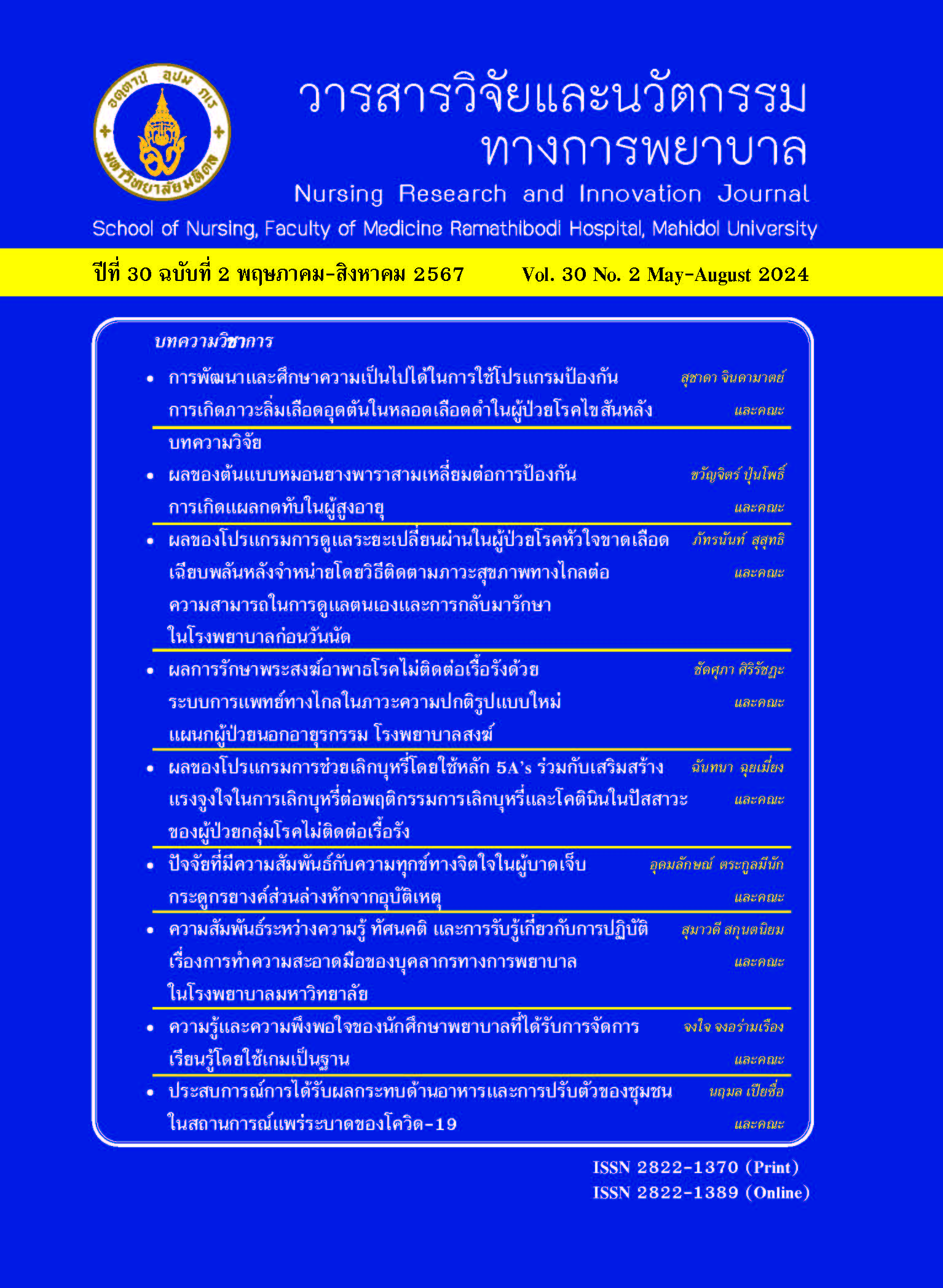Effects of Treatment of Monks with Chronic Non-Communicable Diseases using Telemedicine in the New Normal Situation, Medical Outpatient Department, Priest Hospital
Main Article Content
Abstract
This quasi-experimental research aimed to study the results of treating monks with chronic non-communicable diseases with telemedicine in a new normal situation. A purposive sample was selected from monks with chronic non-communicable diseases, the medical outpatient department, Priest Hospital. There were 135 people receiving telemedicine treatment during the COVID-19outbreak using the guidelines of Medical Services Telemedicine of Priest hospital. The medicines were sent to monks by post, with pharmacists checking the correctness of medicine delivery. The care access was checked by the health promotion department to coordinate information on receiving medicines. The hospital was responsible for the expenses to reduce the risk of spreading the disease.Data were collected using health data records for sick monks and satisfaction questionnaires regarding telemedicine treatment follow-up. Data were analyzed using descriptive statistics and independent t-tests. The results of the study showed that most monks were 60-70 years old (42.2%), used telephones as communication devices (100%), had a need for someone to help using telemedicine (60%), and were interested in telemedicine treatment (98.5%). When comparing the results of laboratory tests before and after telemedicine treatment, it was found that the mean low-density lipoprotein cholesterol level score after using telemedicine was significantly lower than before. There were no differences in mean scores of body mass index, blood pressure, blood sugar, triglycerides,total cholesterol, and high-density lipoprotein levels. The overall satisfaction level with the service was at the highest level. In summary, telemedicine offers an additional option for monks with chronic non-communicable diseases to consult with their physicians, especially during infectious disease outbreaks like COVID-19. It provides a way to manage symptoms, prevent unnecessary hospitalizations, and maintain continuity of care while minimizing the strain on medical facilities and providers. Activities that promote self-care should be added to control the disease and monitor longterm results.
Keywords: New normal, Non-communicable disease, Sick monks, Telemedicine
Article Details

This work is licensed under a Creative Commons Attribution-NonCommercial-NoDerivatives 4.0 International License.
บทความ ข้อมูล เนื้อหา รูปภาพ ฯลฯ ที่ได้รับการตีพิมพ์ในรามาธิบดีพยาบาลสาร ถือเป็นลิขสิทธิ์ของวารสาร หากบุคคลหรือหน่วยงานใดต้องการนำทั้งหมดหรือส่วนหนึ่งส่วนใดไปเผยแพร่หรือเพื่อกระทำการใด ใด จะต้องได้รับอนุญาตเป็นลายลักษณ์อักษรจากรามาธิบดีพยาบาลสารก่อนเท่านั้น
References
Habbash F, Rabeeah A, Huwaidi Z, Abuobaidah H,Alqabbat J, Hayyan F, et al. Telemedicine in noncommunicable chronic diseases care during the COVID-19 pandemic: exploring patients’ perspectives. Front PublicHealth. 2023;1-7.11:1270069. doi: 10.3389/fpubh.
1270069.
Ullas S, Pradeep M, Surendran S, Ravikumar A, Bastine AM, Prasad A, et al. Telemedicine during the COVID-19 pandemic: a paradigm shift in non-communicable disease management? - a cross-sectional survey from a quaternary-care center in South India. Patient Prefer Adherence. 2021;15:2715-23. doi: 10.2147/PPA.S332636. PMID: 34916781; PMCID: PMC8667749.
Department of Medical Services. Project to develop health care for monks and novices all over Thailand. Information office Ministry of Public Health. Ministry of Public Health;2016. (in Thai)
Priest Hospital. Annual report Priest Hospital 2019-2021. Bangkok: Priest Hospital, Department of Medical Services; 2022. (in Thai)
Health Administration Division. Management on new normal medical service. 1st ed. Samutsakhon: Born To Be Publishing; 2020. (in Thai)
Institute of Geriatric Medicine. Review report: The impact of covid-19 on the noncommunicable disease service system. Division of noncommunicable diseases,Department of Disease Control & Institute of geriatric medicine, Department of Medical Services; 2020.
(in Thai)
Phromsiri T. New normal of medical service. interesting medical information. Lak Muang. Office of the Permanent Secretary for the Ministry of Defence; 2020. https://opsd.mod.go.th (in Thai)
Department of Medical Services. Health knowledge:because health care is not difficult. Information office:Department of Medical Services; 2021. https://www.priest-hospital.go.th/about/Telemedicine (in Thai)
Kwanyuen R, Puttapitukpol S. Factors related to beliefs about taking medicines among the monks with noncommunicable diseases. Thai Journal of Cardio-Thoracic Nursing. 2019;30(2):38-48. (in Thai)
Kwanyuen R, Amput P, Siriratchatha C, Sangsanor P. The effect of self-monitoring of blood glucose controlling among monks with diabetes mellitus, Priest Hospital. SDU Research Journal. 2016;9(3):99 – 112. (in Thai)
Department of Medical Services. Guidelines for using DMS Telemedicine. Department of Medical Services; 2023.(in Thai)
Taweesak W. The development of referral for patients with chronic non-communicable diseases using the health network with telehealth model, Phiboonmangsahan district,Ubon Ratchathani province. Academic Journal of Community Public Health. 2023; 9(1):148-59. (in Thai)
Budsayamart B. Development of care model for diabetes or hypertensive patients in the new era, Ampur Mueang,Nakhon Pathom. Region 4-5 Medical Journal. 2023;42 (1):63-77. (in Thai)
World Health Organization. Monitoring the building blocks of health systems: a handbook of indicators and their measurement strategies. Geneva: World Health Organization; 2010. https://iris.who.int/handle/10665/258734
Faul F, Erdfelder E, Lang AG, Buchner A. G*Power 3:A flexible statistical power analysis program for the social,behavioral, and biomedical sciences. Behav Res Methods.2007;39(2):175-91.
Public Sector Development Group. Survey research report on the satisfaction of service recipients with the service quality of the office of the permanent secretary, Ministry of Public Health; 2016. (in Thai)
Kanjanawasee S. Classical test theory. 7th ed. Bangkok:Chulalongkorn University Printing House; 2014. (in Thai)
Thongjood T. A study of factors influenced patients’attitude and behavioral intention to use ramathibodital’s telemedicine service. (Independent Study) Bangkok:Mahidol University; 2020. (in Thai).
Annoppornchai V, Kidhirunkul C. Applications of telemedicine systems for the improvement of quality service in rural emergency medicine. Western University Research Journal of Humanities and Social Science.2021;7(3):258-71. (in Thai)
Kursite M, Stars I, Strele L, Gobina I, Kivite-Urtana A,Behmane A, et al. A mixed-method study on the provision of remote consultations for non-communicable disease patients during the first wave of the COVID-19 pandemic in Latvia: lessons for the future. BMC Health Serv Res.2022;22(1):1-15. https://doi.org/10.1186/s12913-022-07634-x.
Wattanathum K, Dhippayom T, Fuangchan A. Types of activities and outcomes of telepharmacy: A review article.Isan Journal of Pharmaceutical Sciences. 2021;17(3):1-15. (in Thai)
Wiriyapong P, Pongsura S, Fuanchan A, Dhippayom T.The use of telemedicine to support type 2 diabetes care.Journal of Medicine and Health Sciences. 2021;28(2):165-77. (in Thai)
Dermkhuntod N, Kwancharoen R, Chuantantikamol C,Paholpak P, Suraamornkul S. Effects of telehealth monitoring on glycemic control and medication adherence in patients with poorly controlled type 2 diabetes. Vajira Medical Journal: Journal of Urban Medicine. 2020;65:575-90. (in Thai)


